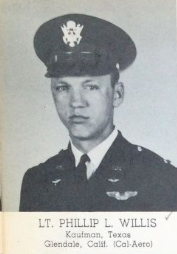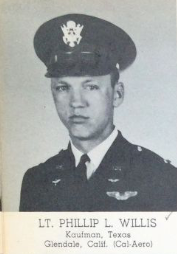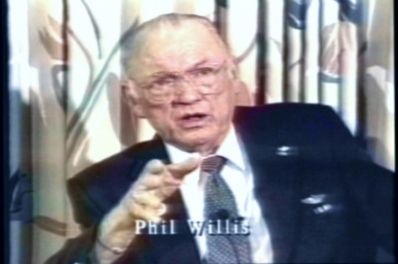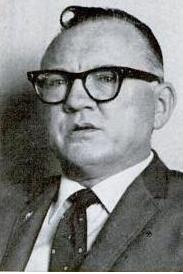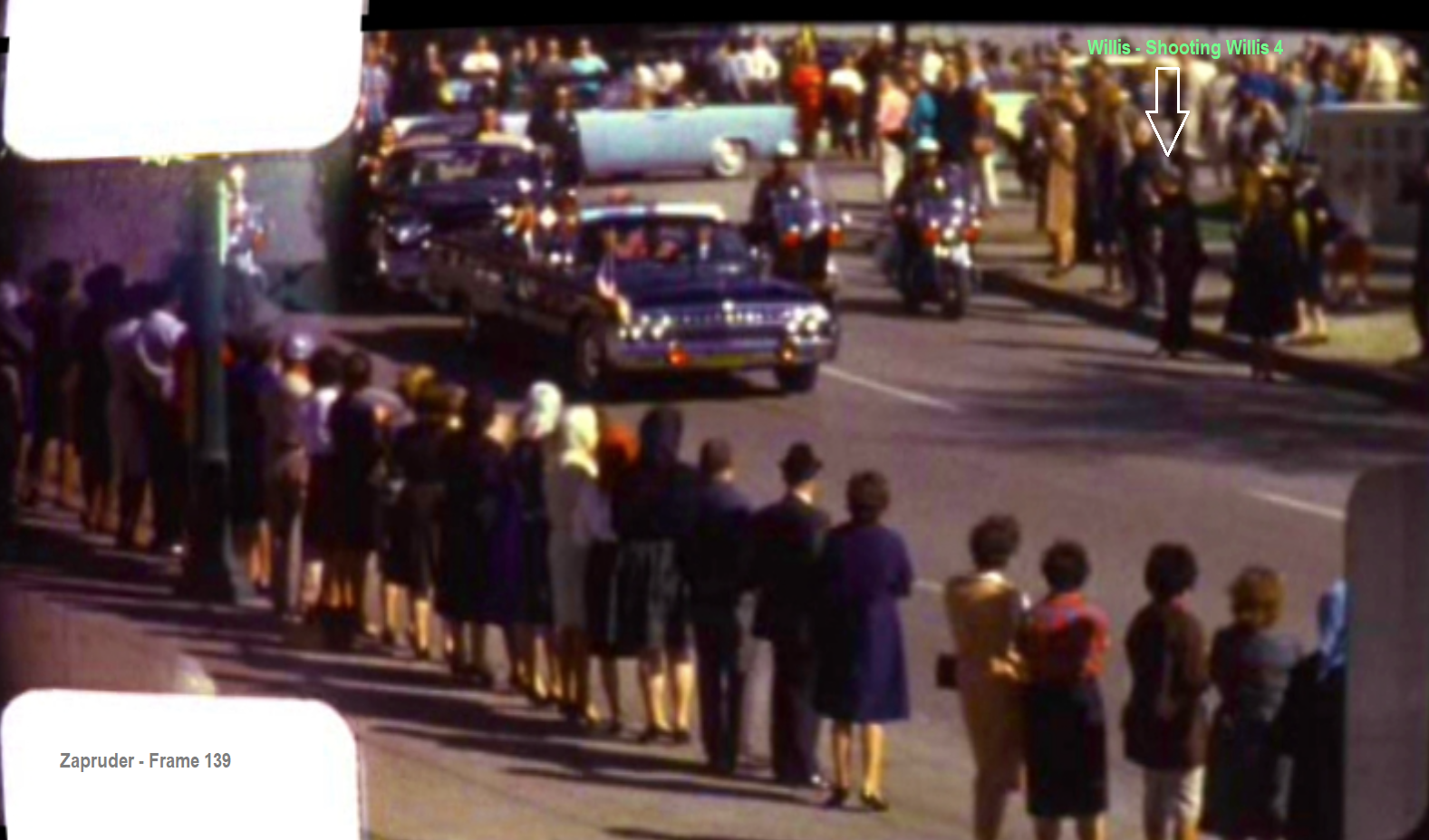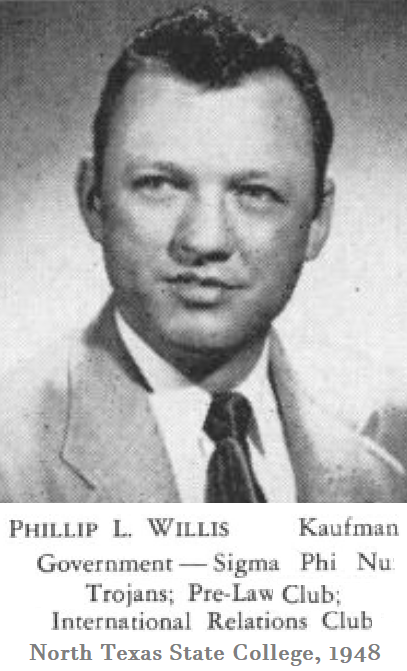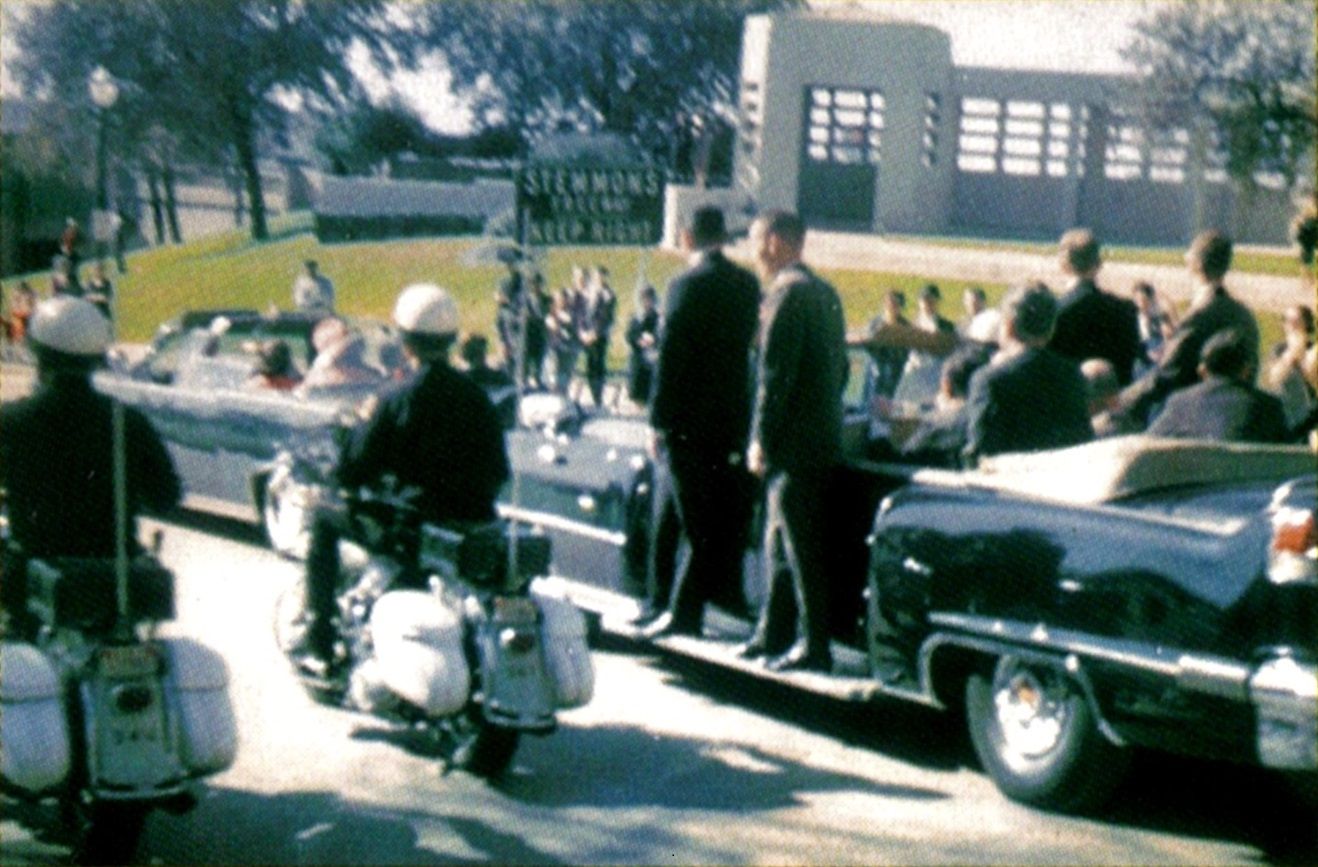Shot The Famous Willis Photos of The JFK Assassination
Willis, a retired Major from the Air Force, and local real estate agent, was not only a Pearl Harbor survivor, but he and his entire family, were also eyewitnesses to the nation's 2nd most shocking and historic event of the 20th century, the assassination of President Kennedy.
According to his Wikipedia bio:
"Willis was stationed at Bellows Field on Oahu, Hawaii as a second lieutenant assigned to the 86th Observation Squadron of the United States Army Air Forces. He was present at the Japanese attack on Pearl Harbor and has been credited with leading the patrol that captured the United States' first Japanese prisoner of war in World War II, Kazuo Sakamaki. Willis flew observation and fighter aircraft, as well as combat missions in the B-17 bomber, prior to retiring in 1946 due to a back injury he sustained after being shot down over the Pacific Ocean. He received various awards and decorations for his military service including two Silver Stars and a Distinguished Flying Cross.
[According to a military database, Willis received a Silver Star when he was a Second Lieutenant in the Army Air Corps (ASN: 0-424601), for gallantry in action as a combat crew member of a United States Heavy Bomber in the 31st Bombardment Squadron, 5th Bombardment Group (Heavy), SEVENTH Air Force, in the Battle of Midway between 3 and 7 June 1942.]
After retiring from the Air Force on disability retirement due to service related injuries, Willis earned a bachelor's degree in government at North Texas State Teachers College in 1948. He was elected to the Texas House of Representatives in 1946 and 1948. As of 1995, Phillip Willis and Doyle Willis were the only brothers to have served at the same time in the Texas House. Afterwards, he worked in real estate, building civil defense shelters, and became an automobile dealer. Willis moved to Dallas in 1960.
The Willis Photos Of The JFK Assassination
On 11/22/63, he, his wife, Marilyn, daughters, Linda, 14, and Rosie, 10, and in-laws, Nina & William Stubblefield, drove to the Downtown Lincoln dealership, where they left their car and and someone gave them a ride to Dealey Plaza to watch JFK's motorcade. They initially stationed themselves in an area where the crowds had thinned out, on the sidewalk at the northwest corner of Houston & Main. The entire family has been identified on that corner in early frames of the Bronson Film(shot by amateur cameraman, Charles Bronson - sadly, someone removed his findagrave memorial, which had a detailed bio and photographs).
In the Bronson Film we see them gathered together by the southwest corner of the Peristyle & Reflecting Pool, at some time prior to the arrival of the Presidential Motorcade. The bright red skirt and white jacket of his little daughter, Rosie, makes them easy to spot. Also captured in the Bronson Film standing in the crowd on that corner, we find close assassination eyewitnesses, Charles Brehm and his little son, Toni Foster & her husband, AP photographer, James "Ike" Altgens, (who took the famous Altgens photos), and the infamous "Babushka Lady". After the motorcade arrived, except for the Willises, they all cut across Dealey Plaza and took up positions in the grassy triangle next to Elm St., and consequently, all became very close eyewitnesses to the assassination.
About 12:20 pm, 10 minutes before the motorcade's arrival, an young UT Arlington college Senior, Jerry Boyd Belkap , had an alleged epileptic siezure on the grassy area by the reflecting pool bordering Houston street, not far from the Willis family. Several officers left their posts to help assist with his care and everyone's attention was focused on him. Officers called an ambulance which came within minutes, and a little before 12:30 pm it departed with Belknap for Parkland Hospital. One witness recounted that the ambulance was just going under the Triple Underpass as the Motorcade was turning the corner from Main onto Houston. Upon arrival at Parkland he was never checked in or treated and promptly disappeared. The Willises like everyone else, witnessed this "emergency," and Rosie, Linda and Marilyn, later recounted how odd it seemed:
"Rosemary:...there was a kid on the corner that had an epileptic seizure. Or appeared to have an epileptic seizure. Which was most interesting because an ambulance came, and if you followed this story, nothing ever became of that. We'll discuss that later. Anyway, no hospital ever received him. Anyway, I always thought at the time that person acted real strangely. Even at age 10, it didn't look like a normal emergency epileptic seizure. There was something strange about it.
Linda: It seemed staged.
Rosemary: Yeah.
Linda: We thought it seemed staged.
Marilyn: But there was a woman that took her handkerchief and dipped it in the reflecting pool there and wiped his brow. She really did.
This episode has caused many JFK assassination researchers to wonder if this was a planned distraction by the conspirators to allow shooters to get into position unnoticed.
After the Presidential limo passed them by, Phil took two photos, then ran over to Elm Street by the TSBD to get more photos, and Rosie and Linda ran after him. Marilyn later recountedy "My whole family was scattered to the winds!" She then walked over to the low wall of the Peristyle behind her, and looked across Dealey Plaza, and Mr. & Mrs. Stubblefield are captured in the Bronson film, as they walked around the south end of the Peristyle, and into the grassy area of Dealey Plaza, to get a view of the Presidential Limo as it proceeded down Elm Street - and was assassinated.
Phil Willis was a lifelong Democrat and JFK supporter, in fact, he and his brother, Doyle, had previously both been Democratic Texas State Representatives. (Indeed, Doyle Willis was the second longest-serving state legislator in the history of Texas and longest serving state legislator from Tarrant County, serving a total of 42 years.) So, Willis had come prepared with his new, 35mm, Argus Autronic I camera, loaded with color slide film, hoping to get some good photos of his beloved President Kennedy, and Vice President Johnson, whom he personally knew.
In all he captured 13 excellent, color slides, before, during, and after the assassination, later known as the "Willis Photos". He had them professionally printed and copyrighted under "Phil Willis Enterprises" and sold them to the public as a set of 13. In addition, he took a photo of the outside of the Kodak Lab where he had his film developed. Some of his photos were subsequently published in the John F. Kennedy Memorial Edition of LIFE magazine, and were also used as Warren Commission exhibits.
Willis's slide #1 was of the Presidential Limo as it came down Main Street approaching the corner of Main and Houston. After it turned onto Houston he captured the Limo with JFK & Jackie right in front of him in slide #2. The limo takes up the entire frame.
Slide #3 has an interesting story. He stepped off the sidewalk into Houston St. to shoot down Houston capturing the rear of Presidential Limo & the Queen Mary (Secret Service Car) as they headed toward the Texas School Book Depository. Unbeknownst to Willis, he stepped in front of the lens of amateur camerawoman, Marie Muchmore, not once, but twice. She was on the Houston St. sidewalk, near the corner of Main & Houston, by the reflecting pool, filming with her new 8 mm Keystone K-7 Zoom-Lens home movie camera, and was with her coworker, amateur photographer, Wilma Bond, who took the famous color "Bond Photos" of the Assassination. The first time Willis passed in front of Muchmre was as she was filming the limo when it first approached the corner of Main & Houston - he walks in front of her from right to left (in the direction of the TSBD), we know now, to take up a position just to her left. And the 2nd time was as she began trying to film the rear of the Limo & Queen Mary. He stepped in front of her to film the same scene, and we see the back of his head, probably not more than a foot or two away from her lens, taking up the left side of her film frames for a moment or two. The color "Muchmore Film" is one of the most famous films of the JFK assassination, since along with that of Orville Nix ("The Nix Film"), and Abraham Zapruder ("The Zapruder Film"), they were the only ones to film JFK on Elm Street at the moment of the head shot.
Willis then immediately ran down the sidewalk ahead of the Presidential Limo, to the sidewalk on Elm St., directly across from the Texas School Book Depository, his daughters chasing him. As the Presidential Limo rounded the corner onto Elm and straightened out in front of him, he stepped into the street and was able to get a beautiful, close up shot of the mid-section of the limo and its beaming passengers, only 10 feet from him, as it proceeded down Elm (slide# 4). In the Zapruder film we see Willis quickly stepping back onto the sidewalk as the motorcade passed by.
He then ran down the sidewalk after the limo, and within three seconds he heard the the first shot ring out. The most famous of his slides is undoubtedly #5, which he testified he took at the exact moment of the first shot he heard that hit JFK - the throat shot. In fact, he testified to the Warren Commission that he ran forward with the camera to his eye, ready to take the next photo at the perfect moment, when he depressed the shutter button in reaction to that first shot. Slide #5 continues to be studied by researchers for possible evidentiary value. Zapruder, on his pedestal diagonally across Elm from Willis, captured JFK almost immediately after he was hit, with his elbows splayed, grabbing his throat, as he emerges from behind the Stemmons Freeway sign. (The throat shot was estimated to have occurred at frame Z-209, and JFK emerges from behind the Stemmons sign, with hands to his throat, at frame Z-225, just under 1 second later.) Willis is seen in the background of the Zapruder film. In addition to his Warren Commission Testimony, Willis also gave a statement to the FBI on July 22, 1964.
The rest of Willis's 13 slides were taken during the aftermath of the assassination. Slides #6 & #7 are looking down Elm as motorcade vehicles, a station wagon in slide 6, and a Press Bus in slide 7, race off down Elm toward the Triple Underpass, along with an encroaching, curious crowd of shocked eyewitnesses. The remaining slides 7-13, are shots of the outside Texas School Book Depository capturing the crowd, police cars and police activities surrounding it.
After the assassination, Willis and his family went to the Kodak Lab at 3131 Manor Way in Dallas, next to Love Field, to get his slides developed; and while there, Abraham Zapruder also came in to get his famous Zapruder film developed.
In 1978, when Willis's daughter Rosemary was interviewed by investigators from the House Select Committee on Assassinations, she stated to the HSCA that her father became upset when the Dallas policemen, sheriffs, and detectives—who first quickly ran onto the grassy knoll where Phillip thought the shots came from—then ran away from the grassy knoll. In Willis's Warren Commission testimony he stated that shots came from the Texas School Book Depository.
However, in a 1979 interview Phil Willis was adamant, leading one to believe his Warren Commission Testimony had been changed, as happened to more than a few eyewitnesses:
"There's no doubt in our mind the final shot that blew his head off did not come from the depository. His head blew up like a halo. The brains and matter went to the left and the rear."
Like the vast majority of the public, Willis and his family members all firmly believed - and his surviving daughters, Rosemary ("Rosie") and Linda, continue to believe - that the head shot was from the front, and that both the assassination itself, and the subsequent 6 decade-plus, coverup were, and are conspiracies.
On January 27, 1995, Willis died of leukemia at his home in Dallas and subsequently, The Texas House passed a resolution to honor him, the text of which follows (caps in the original):
By Willis H.C.R. No. 179
74R11494 T
HOUSE CONCURRENT RESOLUTION
1-1 WHEREAS, The passing of former Representative Phillip
1-2 LaFrance Willis on 27 January 1995, at the age of 76, has brought a
1-3 great loss to the people of Texas and to the many relatives and
1-4 friends of this World War II hero; and
1-5 WHEREAS, A native Texan, he was born in Kaufman, County, on
1-6 August 1918, the son of Alvin Samuel Willis, a school teacher, and
1-7 Eliza Jane Phillips, whose family were early 19th Century settlers
1-8 in Kaufman County; and
1-9 WHEREAS, Upon graduation from the University of North Texas,
1-10 this young Texan entered the USAF Cadet Training School at
Randolph
1-11 Field in October, 1940, was commissioned a 2nd Lieutenant at Brooks
1-12 Field Class 41F in August, 1941, and was assigned to the USAF,
1-13 Bellows Field, Hawaii; and
1-14 WHEREAS, Phil was to have married his sweetheart Marilyn
1-15 Stubblefield, of San Antonio, Texas, in Hawaii, Christmas, 1941,
1-16 but on December 7th, the Japanese attacked Pearl Harbor, and
nearby
1-17 air bases, prompting Mr. Willis to help defend his base; and
1-18 WHEREAS, He then flew one of the two planes from Bellows
1-19 Field that became airborne that day; however, his plane was
1-20 destroyed during the second attack; and
1-21 WHEREAS, He was then assigned as ranking officer to a Beach
1-22 Patrol near Pearl Harbor, and on daybreak, 8 December, 1941, Phil
1-23 Willis captured the United States' first Japanese prisoner of war
1-24 in World War II, Naval Lieutenant Kazuo Sakamaki, the surviving
2-1 member of a two-man Japanese suicide submarine caught on a reef;
2-2 and
2-3 WHEREAS, Phil Willis immediately volunteered and became a
2-4 four-engine B-17 Bomber pilot and in June, 1942, during the Battle
2-5 of Midway, he and his crew were credited with sinking a large
2-6 Japanese troop ship, thereby earning the Silver Star for Gallantry
2-7 in Action; and
2-8 WHEREAS, Throughout his military service, Mr. Willis went on
2-9 to receive a plethora of medals and decorations including the
2-10 Distinguished Flying Cross, the Air Medal with Oak Leaf Cluster,
2-11 the Presidential Unit Citation with Oak Leaf Cluster, the World War
2-12 II Victory Medal, the Air Force Outstanding Unit Award with Bronze
2-13 Star, the Air Force Combat Readiness Medal, the Joint Service
2-14 Achievement Medal, and the Pearl Harbor Commemorative Medal, along
2-15 with eight theater and service medals; and
2-16 WHEREAS, Returning to the United States, he married Marilyn
2-17 on 30 August 1943, and the couple were blessed with two
beautiful
2-18 daughters, Linda Willis Pipes and Rosemary Wills Roach, and four
2-19 grandchildren; and
2-20 WHEREAS, By the time he was retired for combat disabilities
2-21 from the USAF, he had risen to the rank of major; he was later
2-22 elected, along with his brother, Doyle Willis also a decorated WWII
2-23 veteran, to the Texas Legislature, where both brothers share the
2-24 distinction of being the only siblings to have served two
2-25 consecutive terms together in the Texas House of Representatives;
2-26 and
2-27 WHEREAS, As a member of the Texas Legislature, Mr. Willis
3-1 served with honor and distinction, chairing the Committee on
3-2 Constitutional Amendments and sponsoring several important
pieces
3-3 of legislation dealing with agriculture, veterans, education and
3-4 senior citizens; and
3-5 WHEREAS, Upon his retirement from legislative service,
3-6 Mr. Willis settled his family in San Antonio and became President
3-7 and CEO of Phil Willis, Company, a Real Estate Brokerage
Company,
3-8 and he was also a Builder and Developer; and
3-9 WHEREAS, Driven by his strong sense of community spirit,
3-10 Mr. Willis served his friends and neighbors in Bexar County as a
3-11 member of the San Antonio Zoning and Planning Commission; the San
3-12 Antonio Board of Realtors; and in 1952, was named the San
Antonio
3-13 Junior Chamber of Commerce's Outstanding Young Man; and
3-14 WHEREAS, The 1960s saw the Phil Willis family move to Dallas,
3-15 where Mr. Willis established himself as a real estate broker,
3-16 specializing in farm and ranch land, and served on the Dallas
Board
3-17 of Realtors and the Texas Association of Realtors; and
3-18 WHEREAS, Phil Willis, a member of the Christian Church,
3-19 Kaufman, Texas, was also a valued civic leader with memberships
3-20 the Bloomfield Masonic Lodge No. 112, Kaufman, Texas, the
Scottish
3-21 Rite and Hella Temple, Dallas, Texas, a former member of Alzafar
3-22 Shrine and the Mounted Sons of the Desert, San Antonio, Texas;
3-23 The Sons of Confederate War Veterans; the Sons of the Republic of
3-24 Texas; was a close friend of United States Speaker Sam Rayburn;
3-25 and presided as Precinct Election Judge in the Democratic Party.
3-26 People said Phil Willis was "A democrat without prefixes, suffixes
3-27 or apologies," and
4-1 WHEREAS, Phil was also a member of various veterans
4-2 organizations, including the American Legion Post #0165,
Kaufman,
4-3 Texas, a Life member of Veterans of Foreign Wars Post #6796,
4-4 Dallas, Texas; Life member and served as President of the North
4-5 Texas Chapter 4 of the Pearl Harbor Survivors Association; The
4-6 Greater Dallas Veterans Council, The Retired Officers Association,
4-7 The Greater Dallas Retired Officers Association; The 31st Bomb
4-8 Squadron (H), the 11th Bomb Group (H), the 5th Bomb Group (H)
4-9 Association, Inc., and the Military Order of the World Wars
4-10 WHEREAS, Throughout his life, Phillip LaFrance Willis earned
4-11 the respect and of all who were knew him; a man of great
character,
4-12 determination, and courage, his memory will live on for years to
4-13 come through the lasting legacy of achievement he leaves behind;
4-14 now, therefore, be it
4-15 RESOLVED, That the 74th Legislature of the State of Texas
4-16 hereby pay tribute to the life and service of the Honorable Phillip
4-17 LaFrance Willis, and extend deepest sympathy to his wife of 51
4-18 years, Marilyn Willis, and extend deepest sympathy to his children,
4-19 Linda Willis Pipes and Rosemary Willis Roach, and extend deepest
4-20 condolences to his brother and our esteemed colleague, the
4-21 Honorable Doyle Willis; and be it further
4-22 RESOLVED, That an official copy of this resolution be
4-23 prepared for the members of his family and that when the Texas
4-24 House of Representatives adjourns this day, it do so in memory of
4-25 a former esteemed colleague, Phillip LaFrance Willis.
~Rest in Peace...
Researched & written by Linda (48291572)*
*As an aside, I had two uncles who were in ships at Pearl Harbor, who were survivors. So, it's fascinating to think that Phil Willis was also there somewhere.
Shot The Famous Willis Photos of The JFK Assassination
Willis, a retired Major from the Air Force, and local real estate agent, was not only a Pearl Harbor survivor, but he and his entire family, were also eyewitnesses to the nation's 2nd most shocking and historic event of the 20th century, the assassination of President Kennedy.
According to his Wikipedia bio:
"Willis was stationed at Bellows Field on Oahu, Hawaii as a second lieutenant assigned to the 86th Observation Squadron of the United States Army Air Forces. He was present at the Japanese attack on Pearl Harbor and has been credited with leading the patrol that captured the United States' first Japanese prisoner of war in World War II, Kazuo Sakamaki. Willis flew observation and fighter aircraft, as well as combat missions in the B-17 bomber, prior to retiring in 1946 due to a back injury he sustained after being shot down over the Pacific Ocean. He received various awards and decorations for his military service including two Silver Stars and a Distinguished Flying Cross.
[According to a military database, Willis received a Silver Star when he was a Second Lieutenant in the Army Air Corps (ASN: 0-424601), for gallantry in action as a combat crew member of a United States Heavy Bomber in the 31st Bombardment Squadron, 5th Bombardment Group (Heavy), SEVENTH Air Force, in the Battle of Midway between 3 and 7 June 1942.]
After retiring from the Air Force on disability retirement due to service related injuries, Willis earned a bachelor's degree in government at North Texas State Teachers College in 1948. He was elected to the Texas House of Representatives in 1946 and 1948. As of 1995, Phillip Willis and Doyle Willis were the only brothers to have served at the same time in the Texas House. Afterwards, he worked in real estate, building civil defense shelters, and became an automobile dealer. Willis moved to Dallas in 1960.
The Willis Photos Of The JFK Assassination
On 11/22/63, he, his wife, Marilyn, daughters, Linda, 14, and Rosie, 10, and in-laws, Nina & William Stubblefield, drove to the Downtown Lincoln dealership, where they left their car and and someone gave them a ride to Dealey Plaza to watch JFK's motorcade. They initially stationed themselves in an area where the crowds had thinned out, on the sidewalk at the northwest corner of Houston & Main. The entire family has been identified on that corner in early frames of the Bronson Film(shot by amateur cameraman, Charles Bronson - sadly, someone removed his findagrave memorial, which had a detailed bio and photographs).
In the Bronson Film we see them gathered together by the southwest corner of the Peristyle & Reflecting Pool, at some time prior to the arrival of the Presidential Motorcade. The bright red skirt and white jacket of his little daughter, Rosie, makes them easy to spot. Also captured in the Bronson Film standing in the crowd on that corner, we find close assassination eyewitnesses, Charles Brehm and his little son, Toni Foster & her husband, AP photographer, James "Ike" Altgens, (who took the famous Altgens photos), and the infamous "Babushka Lady". After the motorcade arrived, except for the Willises, they all cut across Dealey Plaza and took up positions in the grassy triangle next to Elm St., and consequently, all became very close eyewitnesses to the assassination.
About 12:20 pm, 10 minutes before the motorcade's arrival, an young UT Arlington college Senior, Jerry Boyd Belkap , had an alleged epileptic siezure on the grassy area by the reflecting pool bordering Houston street, not far from the Willis family. Several officers left their posts to help assist with his care and everyone's attention was focused on him. Officers called an ambulance which came within minutes, and a little before 12:30 pm it departed with Belknap for Parkland Hospital. One witness recounted that the ambulance was just going under the Triple Underpass as the Motorcade was turning the corner from Main onto Houston. Upon arrival at Parkland he was never checked in or treated and promptly disappeared. The Willises like everyone else, witnessed this "emergency," and Rosie, Linda and Marilyn, later recounted how odd it seemed:
"Rosemary:...there was a kid on the corner that had an epileptic seizure. Or appeared to have an epileptic seizure. Which was most interesting because an ambulance came, and if you followed this story, nothing ever became of that. We'll discuss that later. Anyway, no hospital ever received him. Anyway, I always thought at the time that person acted real strangely. Even at age 10, it didn't look like a normal emergency epileptic seizure. There was something strange about it.
Linda: It seemed staged.
Rosemary: Yeah.
Linda: We thought it seemed staged.
Marilyn: But there was a woman that took her handkerchief and dipped it in the reflecting pool there and wiped his brow. She really did.
This episode has caused many JFK assassination researchers to wonder if this was a planned distraction by the conspirators to allow shooters to get into position unnoticed.
After the Presidential limo passed them by, Phil took two photos, then ran over to Elm Street by the TSBD to get more photos, and Rosie and Linda ran after him. Marilyn later recountedy "My whole family was scattered to the winds!" She then walked over to the low wall of the Peristyle behind her, and looked across Dealey Plaza, and Mr. & Mrs. Stubblefield are captured in the Bronson film, as they walked around the south end of the Peristyle, and into the grassy area of Dealey Plaza, to get a view of the Presidential Limo as it proceeded down Elm Street - and was assassinated.
Phil Willis was a lifelong Democrat and JFK supporter, in fact, he and his brother, Doyle, had previously both been Democratic Texas State Representatives. (Indeed, Doyle Willis was the second longest-serving state legislator in the history of Texas and longest serving state legislator from Tarrant County, serving a total of 42 years.) So, Willis had come prepared with his new, 35mm, Argus Autronic I camera, loaded with color slide film, hoping to get some good photos of his beloved President Kennedy, and Vice President Johnson, whom he personally knew.
In all he captured 13 excellent, color slides, before, during, and after the assassination, later known as the "Willis Photos". He had them professionally printed and copyrighted under "Phil Willis Enterprises" and sold them to the public as a set of 13. In addition, he took a photo of the outside of the Kodak Lab where he had his film developed. Some of his photos were subsequently published in the John F. Kennedy Memorial Edition of LIFE magazine, and were also used as Warren Commission exhibits.
Willis's slide #1 was of the Presidential Limo as it came down Main Street approaching the corner of Main and Houston. After it turned onto Houston he captured the Limo with JFK & Jackie right in front of him in slide #2. The limo takes up the entire frame.
Slide #3 has an interesting story. He stepped off the sidewalk into Houston St. to shoot down Houston capturing the rear of Presidential Limo & the Queen Mary (Secret Service Car) as they headed toward the Texas School Book Depository. Unbeknownst to Willis, he stepped in front of the lens of amateur camerawoman, Marie Muchmore, not once, but twice. She was on the Houston St. sidewalk, near the corner of Main & Houston, by the reflecting pool, filming with her new 8 mm Keystone K-7 Zoom-Lens home movie camera, and was with her coworker, amateur photographer, Wilma Bond, who took the famous color "Bond Photos" of the Assassination. The first time Willis passed in front of Muchmre was as she was filming the limo when it first approached the corner of Main & Houston - he walks in front of her from right to left (in the direction of the TSBD), we know now, to take up a position just to her left. And the 2nd time was as she began trying to film the rear of the Limo & Queen Mary. He stepped in front of her to film the same scene, and we see the back of his head, probably not more than a foot or two away from her lens, taking up the left side of her film frames for a moment or two. The color "Muchmore Film" is one of the most famous films of the JFK assassination, since along with that of Orville Nix ("The Nix Film"), and Abraham Zapruder ("The Zapruder Film"), they were the only ones to film JFK on Elm Street at the moment of the head shot.
Willis then immediately ran down the sidewalk ahead of the Presidential Limo, to the sidewalk on Elm St., directly across from the Texas School Book Depository, his daughters chasing him. As the Presidential Limo rounded the corner onto Elm and straightened out in front of him, he stepped into the street and was able to get a beautiful, close up shot of the mid-section of the limo and its beaming passengers, only 10 feet from him, as it proceeded down Elm (slide# 4). In the Zapruder film we see Willis quickly stepping back onto the sidewalk as the motorcade passed by.
He then ran down the sidewalk after the limo, and within three seconds he heard the the first shot ring out. The most famous of his slides is undoubtedly #5, which he testified he took at the exact moment of the first shot he heard that hit JFK - the throat shot. In fact, he testified to the Warren Commission that he ran forward with the camera to his eye, ready to take the next photo at the perfect moment, when he depressed the shutter button in reaction to that first shot. Slide #5 continues to be studied by researchers for possible evidentiary value. Zapruder, on his pedestal diagonally across Elm from Willis, captured JFK almost immediately after he was hit, with his elbows splayed, grabbing his throat, as he emerges from behind the Stemmons Freeway sign. (The throat shot was estimated to have occurred at frame Z-209, and JFK emerges from behind the Stemmons sign, with hands to his throat, at frame Z-225, just under 1 second later.) Willis is seen in the background of the Zapruder film. In addition to his Warren Commission Testimony, Willis also gave a statement to the FBI on July 22, 1964.
The rest of Willis's 13 slides were taken during the aftermath of the assassination. Slides #6 & #7 are looking down Elm as motorcade vehicles, a station wagon in slide 6, and a Press Bus in slide 7, race off down Elm toward the Triple Underpass, along with an encroaching, curious crowd of shocked eyewitnesses. The remaining slides 7-13, are shots of the outside Texas School Book Depository capturing the crowd, police cars and police activities surrounding it.
After the assassination, Willis and his family went to the Kodak Lab at 3131 Manor Way in Dallas, next to Love Field, to get his slides developed; and while there, Abraham Zapruder also came in to get his famous Zapruder film developed.
In 1978, when Willis's daughter Rosemary was interviewed by investigators from the House Select Committee on Assassinations, she stated to the HSCA that her father became upset when the Dallas policemen, sheriffs, and detectives—who first quickly ran onto the grassy knoll where Phillip thought the shots came from—then ran away from the grassy knoll. In Willis's Warren Commission testimony he stated that shots came from the Texas School Book Depository.
However, in a 1979 interview Phil Willis was adamant, leading one to believe his Warren Commission Testimony had been changed, as happened to more than a few eyewitnesses:
"There's no doubt in our mind the final shot that blew his head off did not come from the depository. His head blew up like a halo. The brains and matter went to the left and the rear."
Like the vast majority of the public, Willis and his family members all firmly believed - and his surviving daughters, Rosemary ("Rosie") and Linda, continue to believe - that the head shot was from the front, and that both the assassination itself, and the subsequent 6 decade-plus, coverup were, and are conspiracies.
On January 27, 1995, Willis died of leukemia at his home in Dallas and subsequently, The Texas House passed a resolution to honor him, the text of which follows (caps in the original):
By Willis H.C.R. No. 179
74R11494 T
HOUSE CONCURRENT RESOLUTION
1-1 WHEREAS, The passing of former Representative Phillip
1-2 LaFrance Willis on 27 January 1995, at the age of 76, has brought a
1-3 great loss to the people of Texas and to the many relatives and
1-4 friends of this World War II hero; and
1-5 WHEREAS, A native Texan, he was born in Kaufman, County, on
1-6 August 1918, the son of Alvin Samuel Willis, a school teacher, and
1-7 Eliza Jane Phillips, whose family were early 19th Century settlers
1-8 in Kaufman County; and
1-9 WHEREAS, Upon graduation from the University of North Texas,
1-10 this young Texan entered the USAF Cadet Training School at
Randolph
1-11 Field in October, 1940, was commissioned a 2nd Lieutenant at Brooks
1-12 Field Class 41F in August, 1941, and was assigned to the USAF,
1-13 Bellows Field, Hawaii; and
1-14 WHEREAS, Phil was to have married his sweetheart Marilyn
1-15 Stubblefield, of San Antonio, Texas, in Hawaii, Christmas, 1941,
1-16 but on December 7th, the Japanese attacked Pearl Harbor, and
nearby
1-17 air bases, prompting Mr. Willis to help defend his base; and
1-18 WHEREAS, He then flew one of the two planes from Bellows
1-19 Field that became airborne that day; however, his plane was
1-20 destroyed during the second attack; and
1-21 WHEREAS, He was then assigned as ranking officer to a Beach
1-22 Patrol near Pearl Harbor, and on daybreak, 8 December, 1941, Phil
1-23 Willis captured the United States' first Japanese prisoner of war
1-24 in World War II, Naval Lieutenant Kazuo Sakamaki, the surviving
2-1 member of a two-man Japanese suicide submarine caught on a reef;
2-2 and
2-3 WHEREAS, Phil Willis immediately volunteered and became a
2-4 four-engine B-17 Bomber pilot and in June, 1942, during the Battle
2-5 of Midway, he and his crew were credited with sinking a large
2-6 Japanese troop ship, thereby earning the Silver Star for Gallantry
2-7 in Action; and
2-8 WHEREAS, Throughout his military service, Mr. Willis went on
2-9 to receive a plethora of medals and decorations including the
2-10 Distinguished Flying Cross, the Air Medal with Oak Leaf Cluster,
2-11 the Presidential Unit Citation with Oak Leaf Cluster, the World War
2-12 II Victory Medal, the Air Force Outstanding Unit Award with Bronze
2-13 Star, the Air Force Combat Readiness Medal, the Joint Service
2-14 Achievement Medal, and the Pearl Harbor Commemorative Medal, along
2-15 with eight theater and service medals; and
2-16 WHEREAS, Returning to the United States, he married Marilyn
2-17 on 30 August 1943, and the couple were blessed with two
beautiful
2-18 daughters, Linda Willis Pipes and Rosemary Wills Roach, and four
2-19 grandchildren; and
2-20 WHEREAS, By the time he was retired for combat disabilities
2-21 from the USAF, he had risen to the rank of major; he was later
2-22 elected, along with his brother, Doyle Willis also a decorated WWII
2-23 veteran, to the Texas Legislature, where both brothers share the
2-24 distinction of being the only siblings to have served two
2-25 consecutive terms together in the Texas House of Representatives;
2-26 and
2-27 WHEREAS, As a member of the Texas Legislature, Mr. Willis
3-1 served with honor and distinction, chairing the Committee on
3-2 Constitutional Amendments and sponsoring several important
pieces
3-3 of legislation dealing with agriculture, veterans, education and
3-4 senior citizens; and
3-5 WHEREAS, Upon his retirement from legislative service,
3-6 Mr. Willis settled his family in San Antonio and became President
3-7 and CEO of Phil Willis, Company, a Real Estate Brokerage
Company,
3-8 and he was also a Builder and Developer; and
3-9 WHEREAS, Driven by his strong sense of community spirit,
3-10 Mr. Willis served his friends and neighbors in Bexar County as a
3-11 member of the San Antonio Zoning and Planning Commission; the San
3-12 Antonio Board of Realtors; and in 1952, was named the San
Antonio
3-13 Junior Chamber of Commerce's Outstanding Young Man; and
3-14 WHEREAS, The 1960s saw the Phil Willis family move to Dallas,
3-15 where Mr. Willis established himself as a real estate broker,
3-16 specializing in farm and ranch land, and served on the Dallas
Board
3-17 of Realtors and the Texas Association of Realtors; and
3-18 WHEREAS, Phil Willis, a member of the Christian Church,
3-19 Kaufman, Texas, was also a valued civic leader with memberships
3-20 the Bloomfield Masonic Lodge No. 112, Kaufman, Texas, the
Scottish
3-21 Rite and Hella Temple, Dallas, Texas, a former member of Alzafar
3-22 Shrine and the Mounted Sons of the Desert, San Antonio, Texas;
3-23 The Sons of Confederate War Veterans; the Sons of the Republic of
3-24 Texas; was a close friend of United States Speaker Sam Rayburn;
3-25 and presided as Precinct Election Judge in the Democratic Party.
3-26 People said Phil Willis was "A democrat without prefixes, suffixes
3-27 or apologies," and
4-1 WHEREAS, Phil was also a member of various veterans
4-2 organizations, including the American Legion Post #0165,
Kaufman,
4-3 Texas, a Life member of Veterans of Foreign Wars Post #6796,
4-4 Dallas, Texas; Life member and served as President of the North
4-5 Texas Chapter 4 of the Pearl Harbor Survivors Association; The
4-6 Greater Dallas Veterans Council, The Retired Officers Association,
4-7 The Greater Dallas Retired Officers Association; The 31st Bomb
4-8 Squadron (H), the 11th Bomb Group (H), the 5th Bomb Group (H)
4-9 Association, Inc., and the Military Order of the World Wars
4-10 WHEREAS, Throughout his life, Phillip LaFrance Willis earned
4-11 the respect and of all who were knew him; a man of great
character,
4-12 determination, and courage, his memory will live on for years to
4-13 come through the lasting legacy of achievement he leaves behind;
4-14 now, therefore, be it
4-15 RESOLVED, That the 74th Legislature of the State of Texas
4-16 hereby pay tribute to the life and service of the Honorable Phillip
4-17 LaFrance Willis, and extend deepest sympathy to his wife of 51
4-18 years, Marilyn Willis, and extend deepest sympathy to his children,
4-19 Linda Willis Pipes and Rosemary Willis Roach, and extend deepest
4-20 condolences to his brother and our esteemed colleague, the
4-21 Honorable Doyle Willis; and be it further
4-22 RESOLVED, That an official copy of this resolution be
4-23 prepared for the members of his family and that when the Texas
4-24 House of Representatives adjourns this day, it do so in memory of
4-25 a former esteemed colleague, Phillip LaFrance Willis.
~Rest in Peace...
Researched & written by Linda (48291572)*
*As an aside, I had two uncles who were in ships at Pearl Harbor, who were survivors. So, it's fascinating to think that Phil Willis was also there somewhere.
Inscription
US Air Force veteran
Gravesite Details
Pearl Harbor Survivor
Family Members
Sponsored by Ancestry
Advertisement
Advertisement
